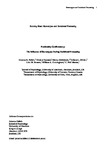Predictably confirmatory: The influence of stereotypes during decisional processing
| dc.contributor.author | Falben, Johanna | |
| dc.contributor.author | Tsamadi, D | |
| dc.contributor.author | Golubickis, Marius | |
| dc.contributor.author | Olivier, JL | |
| dc.contributor.author | Persson, LM | |
| dc.contributor.author | Cunningham, WA | |
| dc.contributor.author | Macrae, CN | |
| dc.date.accessioned | 2020-04-07T10:31:43Z | |
| dc.date.available | 2020-04-07T10:31:43Z | |
| dc.date.issued | 2019-10 | |
| dc.identifier.issn | 1747-0218 | |
| dc.identifier.issn | 1747-0226 | |
| dc.identifier.uri | http://hdl.handle.net/10026.1/15519 | |
| dc.description.abstract |
<jats:p>Stereotypes facilitate the processing of expectancy-consistent (vs expectancy-inconsistent) information, yet the underlying origin of this congruency effect remains unknown. As such, here we sought to identify the cognitive operations through which stereotypes influence decisional processing. In six experiments, participants responded to stimuli that were consistent or inconsistent with respect to prevailing gender stereotypes. To identify the processes underpinning task performance, responses were submitted to a hierarchical drift diffusion model (HDDM) analysis. A consistent pattern of results emerged. Whether manipulated at the level of occupational (Expts. 1, 3, and 5) or trait-based (Expts. 2, 4, and 6) expectancies, stereotypes facilitated task performance and influenced decisional processing via a combination of response and stimulus biases. Specifically, (1) stereotype-consistent stimuli were classified more rapidly than stereotype-inconsistent stimuli; (2) stereotypic responses were favoured over counter-stereotypic responses (i.e., starting-point shift towards stereotypic responses); (3) less evidence was required when responding to stereotypic than counter-stereotypic stimuli (i.e., narrower threshold separation for stereotypic stimuli); and (4) decisional evidence was accumulated more efficiently for stereotype-inconsistent than stereotype-consistent stimuli and when targets had a typical than atypical facial appearance. Collectively, these findings elucidate how stereotypes influence person construal.</jats:p> | |
| dc.format.extent | 2437-2451 | |
| dc.format.medium | Print-Electronic | |
| dc.language | en | |
| dc.language.iso | eng | |
| dc.publisher | SAGE Publications | |
| dc.subject | Stereotypes | |
| dc.subject | person construal | |
| dc.subject | congruency effects | |
| dc.subject | decisional processing | |
| dc.subject | drift diffusion model | |
| dc.title | Predictably confirmatory: The influence of stereotypes during decisional processing | |
| dc.type | journal-article | |
| dc.type | Journal Article | |
| plymouth.author-url | https://www.webofscience.com/api/gateway?GWVersion=2&SrcApp=PARTNER_APP&SrcAuth=LinksAMR&KeyUT=WOS:000483811400007&DestLinkType=FullRecord&DestApp=ALL_WOS&UsrCustomerID=11bb513d99f797142bcfeffcc58ea008 | |
| plymouth.issue | 10 | |
| plymouth.volume | 72 | |
| plymouth.publication-status | Published | |
| plymouth.journal | Quarterly Journal of Experimental Psychology | |
| dc.identifier.doi | 10.1177/1747021819844219 | |
| plymouth.organisational-group | /Plymouth | |
| plymouth.organisational-group | /Plymouth/Faculty of Health | |
| plymouth.organisational-group | /Plymouth/Faculty of Health/School of Psychology | |
| plymouth.organisational-group | /Plymouth/REF 2021 Researchers by UoA | |
| plymouth.organisational-group | /Plymouth/REF 2021 Researchers by UoA/UoA04 Psychology, Psychiatry and Neuroscience | |
| plymouth.organisational-group | /Plymouth/REF 2021 Researchers by UoA/UoA04 Psychology, Psychiatry and Neuroscience/UoA04 Psychology, Psychiatry and Neuroscience MANUAL | |
| plymouth.organisational-group | /Plymouth/Users by role | |
| plymouth.organisational-group | /Plymouth/Users by role/Academics | |
| dc.publisher.place | England | |
| dc.identifier.eissn | 1747-0226 | |
| dc.rights.embargoperiod | Not known | |
| rioxxterms.versionofrecord | 10.1177/1747021819844219 | |
| rioxxterms.licenseref.uri | http://www.rioxx.net/licenses/all-rights-reserved | |
| rioxxterms.type | Journal Article/Review |


